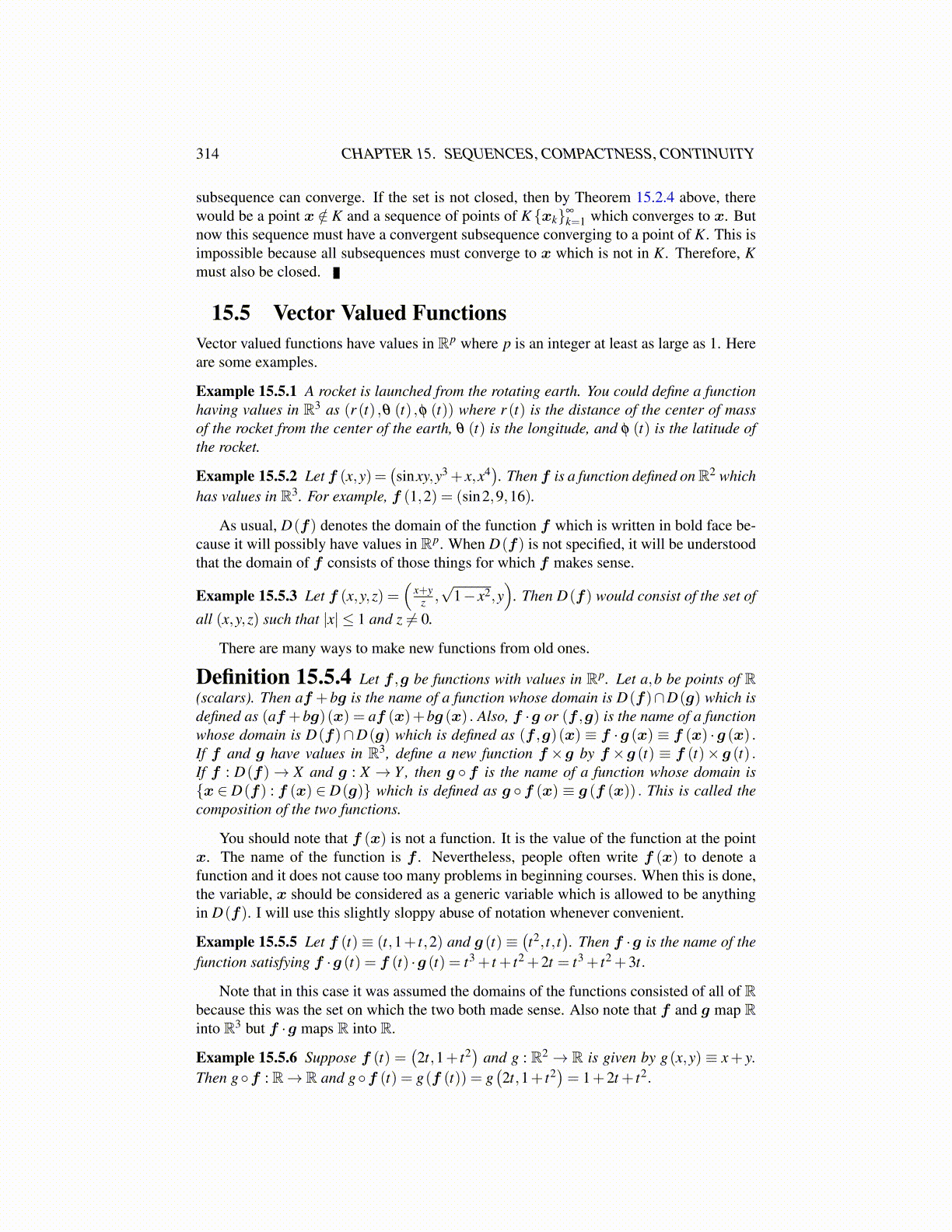
314 CHAPTER 15. SEQUENCES, COMPACTNESS, CONTINUITY
subsequence can converge. If the set is not closed, then by Theorem 15.2.4 above, therewould be a point x /∈ K and a sequence of points of K {xk}∞
k=1 which converges to x. Butnow this sequence must have a convergent subsequence converging to a point of K. This isimpossible because all subsequences must converge to x which is not in K. Therefore, Kmust also be closed.
15.5 Vector Valued FunctionsVector valued functions have values in Rp where p is an integer at least as large as 1. Hereare some examples.
Example 15.5.1 A rocket is launched from the rotating earth. You could define a functionhaving values in R3 as (r (t) ,θ (t) ,φ (t)) where r (t) is the distance of the center of massof the rocket from the center of the earth, θ (t) is the longitude, and φ (t) is the latitude ofthe rocket.
Example 15.5.2 Let f (x,y)=(sinxy,y3 + x,x4
). Then f is a function defined on R2 which
has values in R3. For example, f (1,2) = (sin2,9,16).
As usual, D(f) denotes the domain of the function f which is written in bold face be-cause it will possibly have values in Rp. When D(f) is not specified, it will be understoodthat the domain of f consists of those things for which f makes sense.
Example 15.5.3 Let f (x,y,z) =(
x+yz ,
√1− x2,y
). Then D(f) would consist of the set of
all (x,y,z) such that |x| ≤ 1 and z ̸= 0.
There are many ways to make new functions from old ones.
Definition 15.5.4 Let f ,g be functions with values in Rp. Let a,b be points of R(scalars). Then af +bg is the name of a function whose domain is D(f)∩D(g) which isdefined as (af +bg)(x) = af (x)+bg (x) . Also, f ·g or (f ,g) is the name of a functionwhose domain is D(f)∩D(g) which is defined as (f ,g)(x) ≡ f ·g (x) ≡ f (x) ·g (x) .If f and g have values in R3, define a new function f ×g by f ×g (t) ≡ f (t)× g (t) .If f : D(f) → X and g : X → Y , then g ◦ f is the name of a function whose domain is{x ∈ D(f) : f (x) ∈ D(g)} which is defined as g ◦f (x) ≡ g (f (x)) . This is called thecomposition of the two functions.
You should note that f (x) is not a function. It is the value of the function at the pointx. The name of the function is f . Nevertheless, people often write f (x) to denote afunction and it does not cause too many problems in beginning courses. When this is done,the variable, x should be considered as a generic variable which is allowed to be anythingin D(f). I will use this slightly sloppy abuse of notation whenever convenient.
Example 15.5.5 Let f (t)≡ (t,1+ t,2) and g (t)≡(t2, t, t
). Then f ·g is the name of the
function satisfying f ·g (t) = f (t) ·g (t) = t3 + t + t2 +2t = t3 + t2 +3t.
Note that in this case it was assumed the domains of the functions consisted of all of Rbecause this was the set on which the two both made sense. Also note that f and g map Rinto R3 but f ·g maps R into R.
Example 15.5.6 Suppose f (t) =(2t,1+ t2
)and g : R2 → R is given by g(x,y) ≡ x+ y.
Then g◦f : R→ R and g◦f (t) = g(f (t)) = g(2t,1+ t2
)= 1+2t + t2.